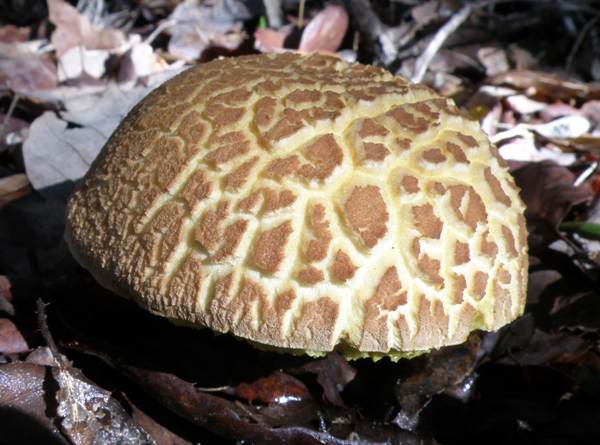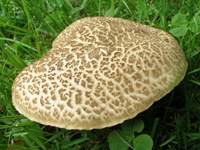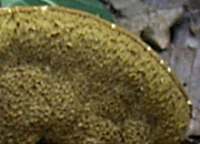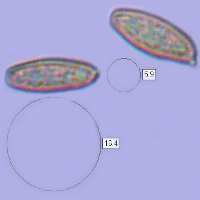Trees Birds Mammals Fish Amphibians Reptiles
Wild Algarve
Bookshop
Xerocomellus porosporus (Imler ex Bon) Šutara - Sepia Bolete
Phylum: Basidiomycota - Class: Agaricomycetes - Order: Boletales - Family: Boletaceae
Distribution - Taxonomic History - Etymology - Identification - Culinary Notes - Reference Sources

A rather ugly bolete, particularly when mature, Boletus porosporus,
the Sepia Bolete, is a rare to occasional find in summer and autumn.
This is not a difficult bolete to identify, but its distinguishing features are to do with its undistinguished appearance in comparison with other boletes whose caps develop cracks: no pretty red stem; no red cap flesh showing through the cracks; and no distinctive features on its subfusiform (typical of boletes) spores.
Distribution
This bolete is uncommon to rare in most parts of Britain and Ireland. It is also found occasionally in many other countries on mainland Europe and is reported from parts on North America.
Taxonomic history
This bolete was described and given the scientific name Xerocomus porosporus in 1958 by Louis Imler (1900 - 1993), who was the founder of the Antwerp Mycological Circle. The currently-accepted scientific name Xerocomellus porosporus dates from a 2008 publication by Czech mycologist Josef Šutara, whose studied in detail morphological character of this and other closely-related boletes - since further supported by DNA studies.
Synonyms of Xerocomellus porosporus include Xerocomus porosporus Imler and Boletus porosporus Imler ex G. Moreno and Bon.
Etymology
The generic name Boletus comes from the Greek bolos, meaning 'lump of clay', while the new genus name Xerocomellus indicates a (rather distant, actually) relationship with the genus Xerocomus. The prefix Xero- means dry.
The meaning of the specific epithet porosporus comes from the prefix poro- meaning 'a cavity, opening, passage or pore' and sporus, 'relating to spores'. This is a reference to the shape of the spores, which have a noticeable germ pore at the truncate end.
Identification guide
 |
Cap
Boletus porosporus, the Sepia Bolete, has a shallow,
convex sepia brown to orange brown cap with a subtomentose (finely velvety) surface that soon cracks extensively in a crazy paving pattern. The soft flesh that shows through the wide cracks is pale cream.
4 to 8cm in diameter when fully expanded, the caps become almost flat when fully mature. |
 |
Tubes and Pores
The yellow tubes terminate in large, angular
pores that are lemon yellow at first but darken with age. When bruised, the pores of mature specimens turn blue.
Stem
The stem of Boletus porosporus has no ring, is greyish sepia with a slight reddish flush near the apex and is covered in longitudinal brownish fibrils. 1 to 2cm in diameter and 3 to 6cm tall, the stem is more or less
constant in diameter throughout its length apart from usually having a slightly bulbous base. |
 |
Spores
Subfusiform, truncate at one end, smooth; 11.5-17 x 4.5-6.5µm.
Spore print
Olivaceous brown. |
Odour/taste |
Not distinctive. |
Habitat & Ecological role |
This ectomycorrhizal mushroom is most likely to be found beneath oak trees. |
Season |
Sepia Boletes appear mainly from August to November. |
Occurrence |
Uncommon to rare in Britain and Ireland, Xerocomellus porosporus occurs also on mainland Europe and in North America. |
Similar species |
Boletus cisalpinus has a yellow stem that is flushed red in the lower part and blues when cut or bruised near the stem base; its spores are finely striated.
Pseudoboletus parasiticus (synonyms Xerocomus parasiticus and Boletus parasiticus) has a dirty yellow stem without red fibrils, and it occurs only with the Common Earthball (Scleroderma citrinum) upon which it may be slightly parasitic. |
Culinary Notes
Xerocomellus pruinatus is generally considered edible, but it is regarded as a mushroom of poor texture and flavour. It is unlikely that you will ever find sufficient for this bolete to ever justify making a meal of it - in any sense!
Reference Sources
Fascinated by Fungi, 2nd Edition, Pat O'Reilly 2016, reprinted by Coch-y-bonddu Books in 2022.
British Boletes, with keys to species, Geoffrey Kibby (self published) 3rd Edition 2012.
BMS List of English Names for Fungi
Dictionary of the Fungi; Paul M. Kirk, Paul F. Cannon, David W. Minter and J. A. Stalpers; CABI, 2008
Taxonomic history and synonym information on these pages is drawn from many sources but in particular from the British Mycological Society's GB Checklist of Fungi.
Top of page...
Fascinated by Fungi. Back by popular demand, Pat O'Reilly's best-selling 450-page hardback book is available now. The latest second edition was republished with a sparkling new cover design in September 2022 by Coch-y-Bonddu Books. Full details and copies are available from the publisher's online bookshop...